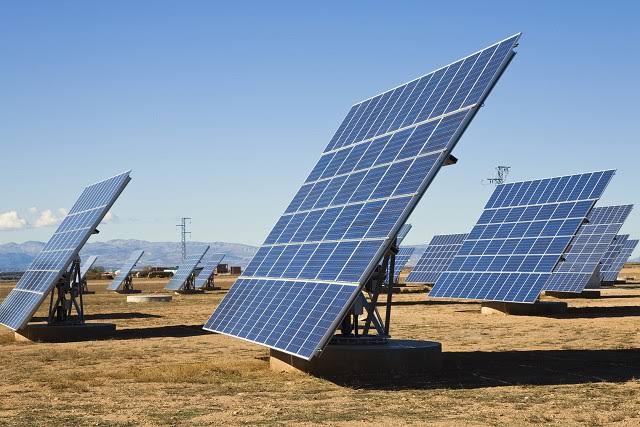Understanding What Happens To Used Solar Panels

You might think of solar panels as a top sustainability solution. While it’s true that they’re terrific for harnessing renewable energy from the sun, photovoltaic panels have an oft-ignored downside: they are very hard to recycle. Because solar cells include heavy metals like lead and cadmium, it’s dangerous to toss them in the landfill. Unfortunately, this is where the panels often wind up once they’ve outlived their usefulness. People are still trying to figure out how to boost large-scale recycling of solar panels in a safe and cost-effective way.
What are solar panels made of?
One of the most important components of a solar panel is silicon. After oxygen, silicon is the second biggest element in our planet’s crust. There are three main approaches to making silicon into panels. Monocrystalline solar panels are the most efficient and expensive. Manufacturers cut individual wafers from a large silicon block and then affix the wafers to panels. This labor-intensive process produces the sleekest-looking, premium solar panels.
Polycrystalline solar cells are made by melting many silicon crystals together, then fusing them en masse onto a panel. These are blueish and are less expensive than monocrystalline panels but also less efficient. Amorphous silicon cells aren’t very efficient, but they are thin and flexible. This filmy material is attached to metal, glass or plastic.
But the cells alone can’t deliver electricity. Power generation requires wiring and metal casing. Standard solar panels also include a glass casing on the panel’s front for protection against damage and temperature increases, which decrease efficiency.
Lifespan of solar panels
When people invest in costly solar panels for their homes or businesses, they often hope they will last forever. But current models lose between 6% and 10% efficiency after about 10 years. By the 25-year mark, the maximum decrease in efficiency is 20%. However, high-quality panels could last 30 to 40 years with reasonable efficiency and continue to function afterward, though not at their top capacity.
The challenge of recycling solar panels
In 2016, the International Renewable Energy Agency (IRENA) estimated that there were about 250,000 metric tons of solar panel waste worldwide. As more panels reach the end of their lifespans, the agency expects that figure to approach 78 million metric tons by 2050.
One of the problems is that solar panels are so big. They have to be, because large surfaces are required to collect enough sunlight. As such, solar panels require way more raw materials, including glass, rare earth elements and heavy metals, than other energy sources.
Unfortunately, you can’t just put the panels out with your recycling bin. Toxic chemicals would need to be removed first, and this can’t happen without breaking the whole panel apart. “Approximately 90% of most PV modules are made up of glass,” said Dustin Mulvaney, environmental studies professor at San Jose State. “However, this glass often cannot be recycled as float glass due to impurities. Common problematic impurities in glass include plastics, lead, cadmium and antimony.”
Experts have disputed the safety of piling panels in landfill. Some say it is safe enough, while others predict that toxic materials will leach into the soil. But even if disposing of panels in landfill was safe, more junk is not welcome.
There’s also an economic incentive for recycling solar panels. According to IRENA’s 2016 report, “If fully injected back into the economy, the value of the recovered material could exceed USD 15 billion by 2050.”
The solar panel recycling process
The most difficult and expensive part of recycling solar panels is breaking them down into their component parts. Once that is done, most parts are recyclable. Recycling silicon-based PV panels involves heating them to 500°C to separate silicon from metal and hardware. Broken pieces of silicon can be melted and reused at a rate of about 85%, according to Greenmatch.
Thin film-based panels are put through a shredder, then a hammer mill, until broken down into liquid and solid materials. Recycling facilities use a rotating screw to then separate out the liquid. After further processing, about 90% of the glass elements and 95% of the semiconductor material can be reused. But unless regulations on recycling solar panels tighten and the price comes down, many panels will still wind up in landfills. Some experts recommend imposing fees on new solar panels that would be held in a decommissioning and disposal fund. This could pay for removing and recycling panels at the end of their useful span.
There’s also a secondary market for old solar panels. After 30 years, a panel might have lost some efficiency, but it still has life left. Some buyers will pay for these used panels if they’re still operational.
What companies recycle solar panels?
European government regulations require solar panel owners to recycle their panels. PV Cycle is probably the biggest name in solar recycling in Europe and beyond. The nonprofit association partners with companies like the French Veolia. In 2018, Veolia opened a recycling plant, relying on robots to separate the glass from silicon, metals and plastics.
Recycle PV is partnering with PV Cycle to export used solar panels to Europe for recycling. While still a small concern, Recycle PV is apt to grow in the next decades, as currently in-use panels lose their effectiveness and have to be removed and replaced.
